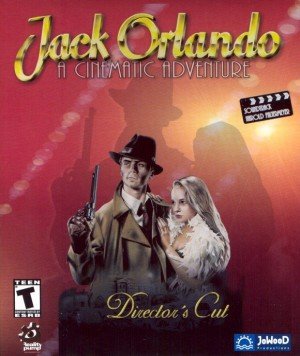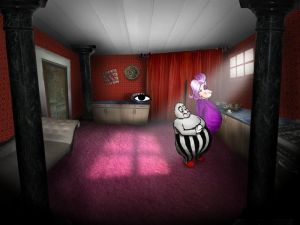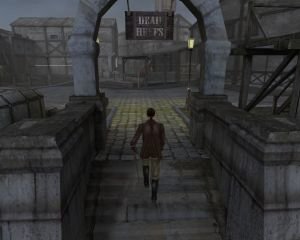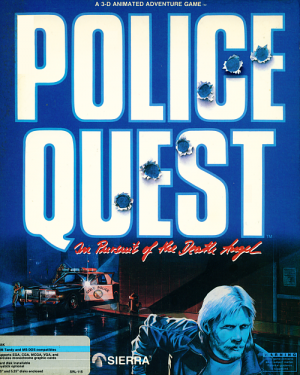Review for Back to the Future: Episode 3 - Citizen Brown

As much as I enjoyed traipsing around Hill Valley circa 1935, it was growing a bit stale. The second episode of Back to the Future, Get Tannen!, seemed like little more than a retread of its predecessor that was more concerned with tying up loose ends than moving the story along. The preview at the end of the episode was a breath of fresh air, promising a surprising new direction for the time-space misadventures of Marty and Doc in the follow-up episode, Citizen Brown.
Suffice it to say, Telltale has delivered on that promise.
After two episodes of playing it relatively safe in terms of messing with established continuity, Telltale has finally decided to go off the rails. Rather than simply picking another historical period for Marty to visit, they have constructed a new and disturbing alternate 1986 Hill Valley that is quite unlike anything we've seen before from the series (though it is in many ways the polar opposite of the Biff-centric dystopian 1986 from the second movie).
We left off last time with Marty having corrected the 1935 timeline, putting the notorious gangster Kid Tannen behind bars and ensuring that his grandfather survives to… well, become his grandfather. However, upon returning to 1986, Marty is stunned to realize that Doc has disappeared from beside him. Before he can figure out what's happening, the DeLorean is wrecked and sticking halfway through a billboard with Marty trapped inside.
Once free, Marty realizes that while he is in 1986, it is definitely not his 1986. Hill Valley has become a walled city, closed to the outside and dedicated to peace, law, and order. Its citizens wear matching clothing and live in both fear and awe of First Citizen Emmet Brown, now a totalitarian leader rather than eccentric scientist, and his wife Citizen Edna. Parking ticket-like “demerits” are doled out like candy for infractions like carrying contraband (alcohol, cigarettes, rock and roll), public displays of affection, and “inadequately polished shoes.” Everything is perfectly, creepily pristine, and the courthouse looks more like a science-fiction fortress than the quaint centerpiece of the town square. As a veteran of the unintended ripple effects of minor alterations to the space-time continuum, Marty immediately sets out to figure out where he went wrong, with his top priority getting an audience with the reclusive Citizen Brown.
This false utopia manages to be fascinating, funny, and disturbing, in no small part because of the fantastic art design that simultaneously fits in with the established style of the previous games and stands on its own. Citizen Brown's Hill Valley is a land of fascist-inspired architecture—clean, angular, and powerful. The city's new emblem, a stylized man raising both arms in the air, is plastered on everything (“I'm not sure if he's cheering or if he's shackled to the wall of a Gulag,” quips Marty) like a humanist swastika. The orange polo shirts worn by every citizen are creepily conformist without falling prey to corny science-fiction costuming clichés. Even though many of the locations you'll visit are the same places you've been in previous episodes, this fresh coat of paint makes them feel new and interesting.
The characters, too, benefit from the change. Regulars like Biff and George (or his father, Artie, who is essentially the same character) were starting to feel a little tired by the end of the second episode, but life in Citizen Brown's world has warped them into bizarre-yet-familiar doppelgängers that steal every scene they're in. Marty's mother and girlfriend, Lorraine and Jennifer, finally make their debuts, both in memorable roles. Jennifer's alternate self strays into self-parody as a punk rocker who has dedicated her free time to rebelling against Citizen Brown's imposed order, but Lorraine makes a lasting impression as one of the more nuanced characters thus far, a quietly sad wife and mother besieged by an overbearing and cold husband (George McFly overbearing? Something really IS wrong in this timeline!). My only complaint in this department is that Citizen Brown only makes a few brief appearances, and while they're doozies, I found myself wanting to see more of this strange, alternate Doc. I suppose in some ways that's a compliment rather than a criticism.
As exemplified by Lorraine's attitude, this episode has taken a welcome turn toward darker territory. One of the hallmarks of the films was their deft mixture of comedy, drama, and suspense—it's almost easy to forget that the first movie alone deals with alcoholism, incest, and even attempted rape. Telltale's second episode mostly stayed in relatively light-hearted territory. Sure, Marty got shot at a few times, but the situation rarely felt more dire than your average Saturday morning cartoon. Citizen Brown, on the other hand, maintains a sense of foreboding that clashes ironically with the overly clean, bright environments of alternate Hill Valley.
Worth noting is Jared Emerson-Johnson's fantastic score, which has thus far stayed slavishly close to Alan Silvestri's original (and with good reason). In this episode, Emerson-Johnson finds an excuse to stray a little from the source, and the result is the most interesting and varied score of the series, mixing familiar themes with an appropriately militaristic, totalitarian motif.
Pretty much everything worth mentioning about this episode has to do with the story and atmosphere—the gameplay remains largely unchanged, for better and for worse. The gameplay is solid; that is, everything works as it should. Controls haven't changed from the now-standard Telltale scheme. You'll spend much of the game trying to rack up demerits throughout the city, with each demerit being its own series of puzzles—all of which are logical but remain far too easy. Whether it's trying to recover lost security camera footage or tracking an elusive dog, the vast majority of obstacles can be solved by applying one of the few usable items in a given room to another hotspot, and all can be overcome in a matter of minutes. Once again, this keeps things moving at a decent clip and helps with the cinematic pacing of the episodes, but it still leaves the experience feeling a bit shallow.
The second episode suffered from a few unsightly bugs and a general feeling of being rushed to meet the deadline. Citizen Brown is an improvement in this regard; there's a greater sense of polish in the environments and animations, and I only encountered one bizarre but non-critical bug involving a floating, disembodied hand that was clearly not supposed to be there. Other than that and one temporary freeze during a scene transition, the game ran smoothly for its four-hour duration.
Those four hours felt like more, however. While the previous episodes weren't significantly shorter, they felt like they zoomed by, whereas Citizen Brown is a bit more deliberately-paced. You'll spend more time digging through extensive dialogue trees and less time dodging gunfire or rocket cars, which isn't inherently a good or bad thing. While there are definitely some slow stretches, overall the episode feels more fleshed-out, with more care given to world-building and characterization. Much of the episode is spent setting up the intense climax and ongoing events of the next episode, but playing through it rarely feels like busywork, if only because every new encounter in the alternate Hill Valley reveals more of the tension and unrest lying under the city's squeaky clean exterior.
In the end, the leap forward in the story helps a lot to counter any disappointment with the gameplay, though the latter won’t change the minds of anyone let down by it in the series so far. For me, the welcome plot developments were enough to still feel satisfied with the episode, and the cliffhanger ending left me ticking off the weeks until the release of Episode 4, Double Vision. If you're a puzzle-focused adventurer, however, feel free to dock an extra star from this review—there just isn't much of that here for you. But for anyone looking to experience a darkly original take on the Back to the Future world that is funny, exciting, and a little disturbing, there's a lot to love about Citizen Brown, so strap in and fire up the time circuits.




























